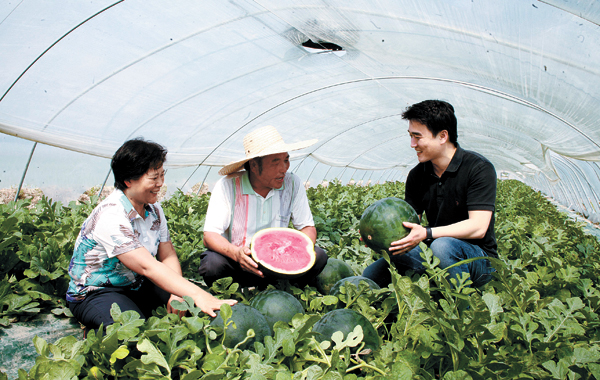The watermelon’s sweet spot

E-Mart’s watermelon buyer Cho Seon-ik, right, checks out a melon with farmer Kim Yeong-soo, center, at Kim’s farm in Haman, South Gyeongsang, on June 12. By Chang Chung-hoon
Retailers are on a warpath to secure the sweetest watermelons - at the lowest prices - by sending their buyers out into the patches to check weather conditions and the growth process of Korea’s No. 1 selling summer fruit.
E-Mart, Homeplus and Lotte Mart said Haman, in South Gyeongsang, is the “heavenly place” to find the best Korean watermelons.
On the afternoon of June 12, Haman’s outdoor temperature already hovered around 30 degrees Celsius (86 degrees Fahrenheit) and inside the greenhouses, melons were growing at temperatures of 50-something degrees.
“This year’s crop is in the most pristine condition I ever harvested in recent years,” said Kim Yeong-su, a 52-year farmer in Haman, who had sweat running down his face. “Each watermelon is larger than an adult’s head and it’s very sweet.”
This year, Kim planted black-skin watermelons instead of the typical green-skin watermelon, and they come with black, zig-zag stripes.
“Last summer we had a long rainy season and the watermelon crops were poor,” Kim said. “I chose a black watermelon this time as it can withstand tough weather.”
Haman is a prime sourcing location, and buyers from the three major discount chains have been waging a form of industrial espionage to secure watermelons with the highest sugar content. Buyers come down to Haman from Seoul to schmooze with farmers and check the latest condition of their cash-cow fruit.
Their top priority is to offer the best-quality watermelons at low prices to consumers by securing large quantities in advance from farmers, and competition is unavoidable, retailers said.
“Watermelon is a cash-cow product in summer, but it also greatly influences sales of other products as consumers who come to buy the fruit end up putting other products in their shopping carts,” said Cho Seon-ik, a watermelon buyer at E-Mart.
E-Mart, Homeplus and Lotte Mart each sell 10 million watermelons per year and 90 percent of them are sold from June to August.
In this period, watermelons give retailers a?combined 10 billion won ($8.6?million)?in monthly sales. But how retailers fare heavily depends on if they manage to secure enough watermelons with high sugar levels.
Last year, retailers saw lower-than-expected sales due to prolonged rain. Prices shot up because demand was greater than supply, but many customers were disappointed that they weren’t that sweet.
To prevent a recurrence, retailers have started their strategies early.
E-Mart came up with the idea of having its contract farmers plant black-skin watermelons, as their roots are thick and burrow deeply underground, which gives them resistance to frequent rainfalls. They are also seedless. The retailer brought black-skin watermelon seeds from the Netherlands and plans to provide over 1.5 million of them this year.
Lotte Mart is rolling out another kind of black-skin watermelon whose seeds are developed by domestic experts.
“Our black-skin watermelon’s harvest period lasts 10 days longer than other watermelons and its sugar content is about 12 Brix, meaning that 12 grams of sugar is contained per 100 grams of the fruit,” said Lotte Mart buyer Lee Seong-yung.
Homeplus is selling a similar kind of watermelon as E-Mart.
This year’s watermelon is being sold cheaper than last year’s, even while it’s sweeter. An eight-kilogram (18.6-pound) watermelon is now selling for 16,000 won compared to 19,900 won last year.
By Chang Chung-hoon, Kim Mi-ju [mijukim@joongang.co.kr]










with the Korea JoongAng Daily
To write comments, please log in to one of the accounts.
Standards Board Policy (0/250자)